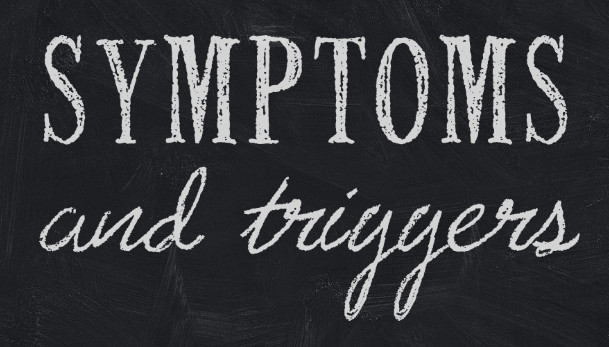SYMPTOMS and TRIGGERS of MISOPHONIA
Definition
The literal definition of misophonia is hatred of sound. However, a person with misophonia does not hate all sounds. They are only sensitive to certain sounds. And those sounds are usually unique to each person. Although any sound can become a problem for a person with misophonia, many are background noises. No one knows why one sound will become a trigger when others do not. Nobody knows why certain people or sounds affect one person and not another.
Trigger Set
People call the collection of sounds that they’re sensitive to their trigger set. It is possible to add to one’s trigger set over time. Additionally, some people are sensitive to the things that they see. Misokinesia is the word that describes having such visual triggers. Visual triggers have been part of misophonia ever since Margaret and Pawel Jastreboff coined the name misophonia over 20 years ago and included visual triggers in their description of misophonia.
Reactions
For people with misophonia, being exposed to a trigger sound creates an immediate negative emotional response. This response can range from moderate discomfort to full-fledged panic and rage. Fight or flight reactions often occur. During a trigger event, a person may become agitated, defensive, or offensive. They may also distance themselves from the trigger or act out in some manner.
Examples
The sound of fingernails scraping down a chalkboard is unpleasant for many people.
But this is a very mild example of what people with misophonia experience. It lacks the intensity associated with misophonia. The fingernail sound doesn’t cause people to have a strong emotional reaction. Not liking something, even if very strongly, doesn’t usually produce a fight or flight reflex.
Relationships
The people closest to the person with misophonia often elicit the most problematic triggers. This unfortunate circumstance can make personal relationships challenging. A person with misophonia can have great difficulty in a group or family environment when many people make different triggering sounds.
Environment
An environment that includes trigger sounds can limit social activities because the person with misophonia anticipates probable trigger events. People with misophonia may isolate themselves in an attempt to reduce the stress that sound triggers cause.
Sharing Information
Those with misophonia can be reluctant to share their symptoms and triggers because sharing can have uncertain outcomes.
Sometimes, people mock those with sound sensitivities. Some go as far as making exaggerated trigger sounds to tease or taunt. In addition, some family, friends, and co-workers try to make light of the problem. Or, people may tell the person with misophonia, “ignore the sound, “you’re difficult,” or “just don’t let it get to you.” These are not likely to be helpful, and a person with misophonia may have difficulty having a calm, rational discussion when feeling a fight or flight response.
People with misophonia cannot ignore their triggers any more than a person with epilepsy can ignore their seizures.
Good Intentions
But, some well-intentioned people are supportive. It is not difficult to honor a request for a non-stimulating environment, and people with a problem or difficulty appreciate small accommodations.
List of Common Triggers
Sometimes, reading about triggers has the potential to make one take on new triggers. But this does not automatically occur. Not all people with misophonia will be bothered by reading about triggers. But a list of common triggers is about to be discussed below.
People Sounds
Mouth and Eating: “ahhs” after drinking, burping, chewing, crunching (ice or other hard food), gulping, gum chewing and popping, kissing sounds, nail-biting, silverware scraping teeth or a plate, slurping, sipping, licking, smacking, spitting, sucking (ice, etc.), swallowing, talking with food in the mouth, tooth brushing, flossing, tooth sucking, lip-smacking, wet mouth sounds, grinding teeth, throat clearing, and jaw clicking.
Breathing/Nasal: grunting, groaning, screaming, loud or soft breathing, sniffling, snorting, snoring, sneezing, loud or quiet talking, raspy voices, congested breathing, hiccups, yawning, nose whistling, and wheezing.
Vocal: humming, muffled talking, nasally voices, overused words such as um or ah (repeated words), sibilant sounds (S, P, T, CH, K, B sounds), singing, gravelly voices, lousy singing, soft whisper-like voices and whistling.
Baby: Baby crying, babbling, adults using baby talk, and kids yelling.
Environmental Sounds
Household/Office: clicking from texting, keyboard/mouse, TV remote, pen clicking, writing sounds, papers rustling/ripping, ticking clocks, texting, and cell phone ringtone.
Utensils/metals: dishes clattering, fork scraping teeth, silverware hitting plates or other silverware, and rattling change in pockets.
Plastic: water bottle squeezing/crinkling, breaking hard plastic, and bouncing balls.
Wrappers: plastic bags crinkling/rustling, plastic bags opening or being rubbed, and crinkling food packages.
Cars: sitting idling for long periods, beep when a vehicle is locked, car doors slamming, keys banging against the steering column, and turn signal clicking.
Heavy equipment: lawnmowers, leaf blower, air conditioners, and chainsaws.
Impact sounds: other people’s voices, muffled bass music, TV sounds coming through walls, slammed doors/windows, and basketball thumps.
Animal noises: dogs barking, bird sounds, crickets, frogs, dogs or cats licking, drinking, slurping, eating, whining, dogs scratching themselves and trying to bite their fleas and claws tapping.
TV: loud TV or radio, static.
Body Movement-related: foot shuffling (dry feet on floor/carpet) or tapping, finger-snapping, foot-dragging, heels, flip-flops, knuckle/joint cracking, eye blinking, nail-biting and clipping, eating, chewing, fidgeting, hair twirling, movements out of the corner of eyes, repetitive foot or body movements, jaw chewing/movement.

